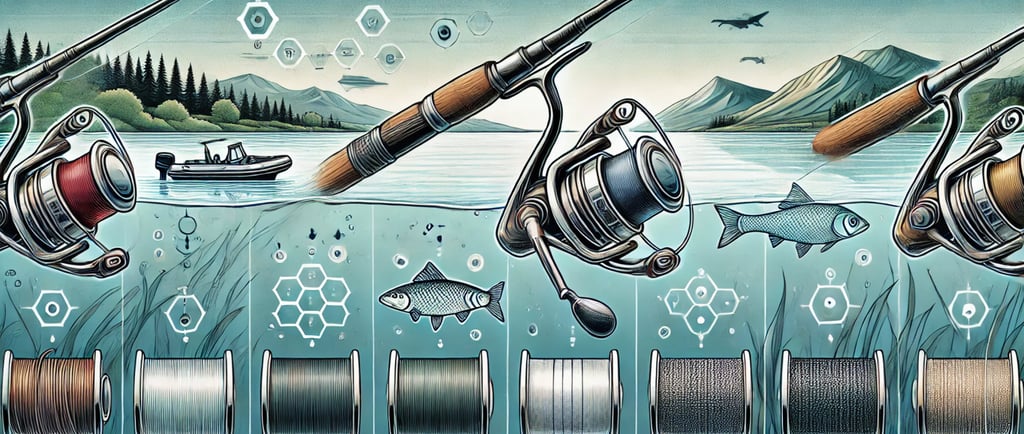
The Science of Fishing Line: How to Choose the Best Line for Your Custom Rod
Choosing the right fishing line is just as important as selecting the perfect custom rod. This guide breaks down the science behind fishing lines, explaining their key properties, strengths, and best uses. Learn the differences between monofilament, fluorocarbon, and braided lines, and discover how each type impacts casting distance, sensitivity, and durability. Whether you're a beginner or a seasoned angler, this blog provides expert tips on selecting, maintaining, and pairing your line with your custom rod for optimal fishing performance.



When it comes to fishing, one of the most critical components of your setup is often overlooked: the fishing line. Whether you’re a seasoned angler or just starting out, understanding the science behind fishing lines can help you make informed choices to enhance your experience on the water. The right line, paired with a custom fishing rod, can make the difference between landing a trophy catch and going home empty-handed. In this guide, we’ll break down the different types of fishing lines and how to choose the best one for your custom rod.
Understanding Fishing Line Properties
Before diving into the types of fishing lines, it’s essential to understand the key properties that define them:
Strength (Pound Test): Refers to the amount of weight a line can handle before breaking. Heavier lines are ideal for large fish, while lighter lines offer better casting distance and sensitivity.
Stretch: Some lines, like monofilament, have more stretch, which can help absorb the shock of a fighting fish. Others, like braided line, have minimal stretch, providing better sensitivity.
Visibility: The line’s color and material determine how visible it is underwater. Clear lines are less detectable to fish, while high-visibility lines are easier for anglers to see.
Diameter: A thinner line creates less drag in the water and improves casting distance, but it may sacrifice strength.
Durability: Resistance to abrasion and UV exposure can impact how long your line lasts in different fishing environments.
Types of Fishing Lines and Their Uses
Monofilament:
Advantages: Affordable, easy to handle, and offers good stretch, making it forgiving for beginners.
Ideal For: Freshwater fishing, general-purpose use, and species like bass or trout.
Drawbacks: Tends to have more memory (line curl) and is less sensitive than other options.
Fluorocarbon:
Advantages: Virtually invisible underwater, highly abrasion-resistant, and sinks faster, making it great for deep-water applications.
Ideal For: Clear water fishing, finesse techniques, and targeting finicky species.
Drawbacks: Stiffer than monofilament, which can make it harder to manage for beginners.
Braided Line:
Advantages: Braided line can last for years without significant degradation, unlike monofilament and fluorocarbon, which can develop line memory in just a few days. It is extremely strong for its diameter, has low stretch for maximum sensitivity, and is highly durable.
Ideal For: Heavy cover fishing, saltwater applications, and large species like redfish or tarpon.
Drawbacks: Costly and highly visible underwater, requiring a fluorocarbon or monofilament leader in clear water.
When to Use Each Type of Line
Inshore Fishing: Fluorocarbon or braided line with a fluorocarbon leader works best due to the combination of strength and low visibility.
Offshore Fishing: Braided lines for large game species, paired with a shock leader for abrasion resistance.
Freshwater Fishing: Monofilament is often sufficient, but fluorocarbon excels in clear water or when using finesse techniques.
Topwater Fishing: Monofilament floats, making it ideal for lures like poppers and frogs.
Deepwater Fishing: Fluorocarbon sinks quickly, getting your bait into the strike zone faster.
How Line Affects Performance with a Custom Rod
The performance of your fishing line is directly tied to the design of your custom rod. A custom rod’s action and power can dictate the best line type to use:
Fast Action Rods: Pair well with braided lines for maximum sensitivity and quick hooksets.
Moderate Action Rods: Work well with monofilament for shock absorption when targeting fish with soft mouths.
Heavy Power Rods: Handle braided lines and heavier fluorocarbon for battling large, strong species.
Light Power Rods: Perform best with lighter monofilament or fluorocarbon lines for targeting smaller fish.
Tips for Beginners
Start with Monofilament: It’s easy to handle, cost-effective, and versatile.
Learn to Tie Knots: Practice tying strong and reliable knots like the improved clinch knot and Palomar knot.
Match Your Line to Your Rod: Check the rod’s specifications for recommended line weight and type.
Replace Your Line Regularly: Monofilament and fluorocarbon degrade over time, especially with UV exposure.
Advanced Tips for Seasoned Anglers
Experiment with Line Layering: Use a braided mainline with a fluorocarbon leader to combine strength, sensitivity, and invisibility.
Adjust Line Weight for Conditions: Go heavier in rough conditions or heavy cover and lighter in open water for better casting distance.
Specialty Lines: Try UV-protected or high-visibility lines for specific conditions or techniques.
Check for Wear: Regularly inspect your line for nicks or abrasions, especially after fishing around rocks or structure.
Maintaining Your Fishing Line
Clean Your Line: After every trip, especially in saltwater, rinse your line with fresh water to remove salt and debris.
Store Properly: Keep your reels in a cool, dark place to prevent UV damage.
Re-spool When Needed: Replace your line periodically to ensure optimal performance.
Conclusion
The fishing line you choose can significantly impact your success on the water. By understanding the science of fishing lines and how they interact with your custom rod, you can tailor your setup to suit your fishing style and conditions. Whether you’re targeting bass in freshwater or redfish in saltwater, the right line will give you the confidence and performance you need to make the most of your time on the water.
Remember, your fishing gear is only as good as the sum of its parts—and that includes the line you use. Choose wisely, and let your custom rod from Sunset Outdoors do the rest.
Tight lines and beautiful sunsets!

Quality, not quantity
We have made quality our habit. It’s not something that we just strive for – we live by this principle every day.

Craftsmanship
Every rod is proudly crafted in Houston, TX with a blend of domestic and imported components.
Contact Us
Copyright © 2025 Sunset Outdoors


